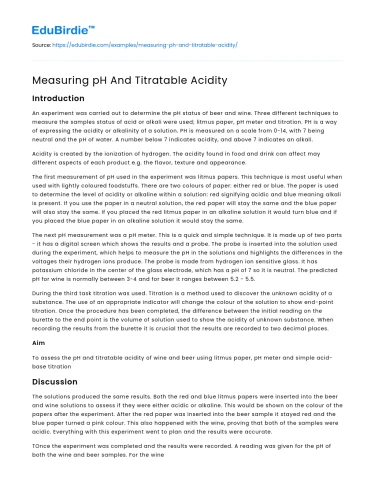Introduction
An experiment was carried out to determine the pH status of beer and wine. Three different techniques to measure the samples status of acid or alkali were used; litmus paper, pH meter and titration. PH is a way of expressing the acidity or alkalinity of a solution. PH is measured on a scale from 0-14, with 7 being neutral and the pH of water. A number below 7 indicates acidity, and above 7 indicates an alkali.
Acidity is created by the ionization of hydrogen. The acidity found in food and drink can affect may different aspects of each product e.g. the flavor, texture and appearance.
Save your time!
We can take care of your essay
- Proper editing and formatting
- Free revision, title page, and bibliography
- Flexible prices and money-back guarantee
The first measurement of pH used in the experiment was litmus papers. This technique is most useful when used with lightly coloured foodstuffs. There are two colours of paper: either red or blue. The paper is used to determine the level of acidity or alkaline within a solution: red signifying acidic and blue meaning alkali is present. If you use the paper in a neutral solution, the red paper will stay the same and the blue paper will also stay the same. If you placed the red litmus paper in an alkaline solution it would turn blue and if you placed the blue paper in an alkaline solution it would stay the same.
The next pH measurement was a pH meter. This is a quick and simple technique. It is made up of two parts - it has a digital screen which shows the results and a probe. The probe is inserted into the solution used during the experiment, which helps to measure the pH in the solutions and highlights the differences in the voltages their hydrogen ions produce. The probe is made from hydrogen ion sensitive glass. It has potassium chloride in the center of the glass electrode, which has a pH of 7 so it is neutral. The predicted pH for wine is normally between 3-4 and for beer it ranges between 5.2 - 5.5.
During the third task titration was used. Titration is a method used to discover the unknown acidity of a substance. The use of an appropriate indicator will change the colour of the solution to show end-point titration. Once the procedure has been completed, the difference between the initial reading on the burette to the end point is the volume of solution used to show the acidity of unknown substance. When recording the results from the burette it is crucial that the results are recorded to two decimal places.
Aim
To assess the pH and titratable acidity of wine and beer using litmus paper, pH meter and simple acid-base titration
Discussion
The solutions produced the same results. Both the red and blue litmus papers were inserted into the beer and wine solutions to assess if they were either acidic or alkaline. This would be shown on the colour of the papers after the experiment. After the red paper was inserted into the beer sample it stayed red and the blue paper turned a pink colour. This also happened with the wine, proving that both of the samples were acidic. Everything with this experiment went to plan and the results were accurate.
TOnce the experiment was completed and the results were recorded. A reading was given for the pH of both the wine and beer samples. For the wine sample the reading was 3.30, the predicted reading was between 3- 4, so this was an accurate result. On the other-hand the result for the beer sample was 4.27. The normal range is said to be between 5.2 - 5.5. The reason behind this could be something to do with the different type of beer used in the experiment. Repeating the experiment more than once or using a different type of beer could be a good way of receiving a more accurate result.
The results for this experiment were recorded in a table. After completing the experiment three times and getting an average, the level of acidity was found in the solution. By repeating the task multiple times, it definitely helped with the accuracy. In order to make the experiment even more accurate, the experimenter could have furthered the titration another three times. An equation was completed to work out the titratability of the beer sample.
Acidity is found in many different food and drinks. Tartaric acid is an acid that is commonly found in fruits such as bananas, apricots and avocados. Malic acid which is found in wine, cherries and other fruits. Lastly citric acid is present in fruits such as lemons, oranges and limes.
The pH can affect food and drink products certain ways such as the quality, texture and taste. For example, if you don’t use a full avocado, squeezing some lemon juice over it, can prevent it from turning brown quickly and becoming unusable. This is because lemons are an antioxidant and have high levels of acidity.
Conclusion
Overall, all tasks were performed well and completed to a high standard. The research done prior to the experiments that both the samples of wine and beer should be acidic. After completing all three tasks the sufficient evidence was gained and the research proved to be accurate.
References
- https://www.explainthatstuff.com/how-ph-meters-work.html
- https://www.bbc.co.uk/bitesize/guides/zx98pbk/revision/1
- https://www.healthline.com/health/acid-foods-to-avoid#effects
- https://winemakermag.com/article/547-phiguring-out-ph
- https://www.gastrograph.com/blogs/gastronexus/quality-control-in-beer-production-part-2.html
- https://food.ndtv.com/ingredient/tartaric-acid-701185
- https://www.thespruceeats.com/keep-avocados-from-turning-brown-1328686






 Stuck on your essay?
Stuck on your essay?

